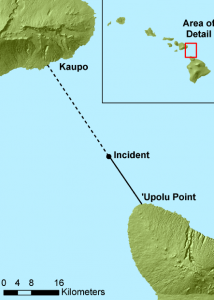
I don’t often cover shark attacks here at Southern Fried Science. They get plenty of news coverage on their own, they’re usually not that relevant from a science and conservation perspective, and they are outside of my expertise and interests. However, some shark attack stories, such as this one, transcend “if it bleeds, it leads” fearmongering journalism and are interesting in their own right.
I’d like to preface this story by saying that shark attacks are extremely rare to begin with (you have a 1 in 5 chance of dying from heart disease and a 1 in 3.8 million chance of being killed by a shark in the United States). If you want to further minimize your chance of being attacked by a shark, most of the few attacks that occur can be prevented by simply swimming close to shore with lots of other people nearby during the day. Even though shark attacks are rare, I still don’t want to minimize the suffering of the few attack victims and their families. With these caveats out of the way, presented below is the fascinating story of what is probably the most preventable shark attack of all time.
In 2009, an experienced swimmer thought it would be a fun challenge to swim between the main island of Hawaii and Maui (hey, some people collect stamps, some swim between islands). He expected it to take between 16 and 20 hours to cover the 47 kilometer distance. The swim involved crossing the ‘Alenuihähä channel, which includes a stretch of relatively deep water.

As is common practice with long-distance swims, the swimmer was closely followed by a support boat, available just in case the swimmer needed assistance. Once the sun set, the support boat shined lights on the swimmer to make sure they wouldn’t lose him. They soon noticed large numbers of squid, presumably attracted to the lights.
To recap, our long-distance swimmer is now in the middle of the Pacific ocean, swimming over a deep-water canyon, at night, brightly lit from above by floodlights.
Into this unlikely situation came one of the strangest species of sharks, the cookiecutter. These animals generally live in the deep sea, but sometimes venture closer to the surface at night in search of prey, such as squid. They have a peculiar method of feeding that basically involves biting a circular chunk of meat right off the side of their prey.
Here is the painful (but fortunately non-fatal) result of our swimmer’s encounter with a cookiecutter shark (that’s his leg):

By swimming in the middle of the ocean, over a deepwater trench, at night, while being brightly lit from above, our swimmer became the first confirmed human target of a cookiecutter shark bite, and became the victim of what is likely the most preventable shark attack of all time.
Randy Honebrink,Robert Buch, Peter Galpin, and George H. Burgess (2011). First Documented Attack on a Live Human by a Cookiecutter Shark. Pacific Science

…and surrounded by bait.
David,
You had me going there for a minute thinking we missed a 2011 shark attack or related incident. The incident you are referring to actually happened in 2009 to Mike Spalding. Here is a bit more info on the incident and proof it happened in 2009 not 2011.
http://sharkattacksurvivors.com/shark_attack/viewtopic.php?f=44&t=1239
Al Brenneka
Thanks for the correction, and apologies for the trouble. The paper describing the incident was published in 2011, but the incident happened in 2009. I’ll correct the post.
And covered here in 2009: http://coralnotesfromthefield.blogspot.com/2009/03/attack-of-cookie-monster.html
🙂
“By swimming in the middle of the ocean, over a deepwater trench, at night, while being brightly lit from above, our swimmer became the first confirmed human target of a cookiecutter shark bite, and became the victim of what is likely the most preventable shark attack of all time.”
Is it wrong that I laughed out loud at that?